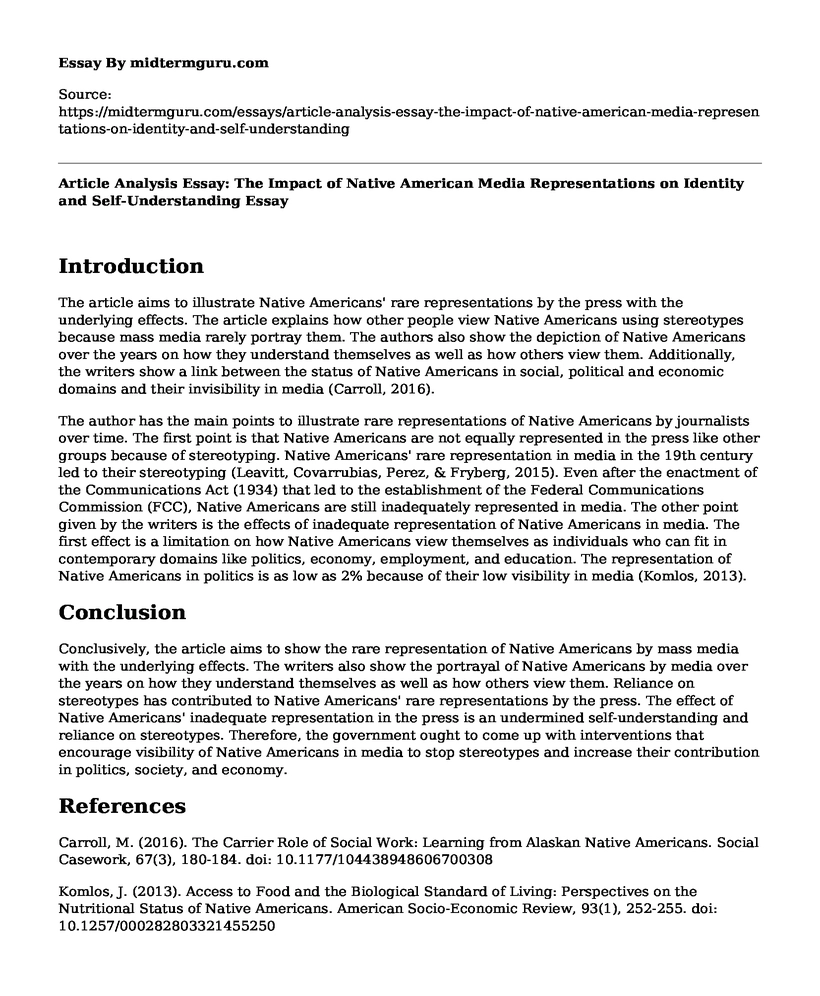Introduction
The article aims to illustrate Native Americans' rare representations by the press with the underlying effects. The article explains how other people view Native Americans using stereotypes because mass media rarely portray them. The authors also show the depiction of Native Americans over the years on how they understand themselves as well as how others view them. Additionally, the writers show a link between the status of Native Americans in social, political and economic domains and their invisibility in media (Carroll, 2016).
The author has the main points to illustrate rare representations of Native Americans by journalists over time. The first point is that Native Americans are not equally represented in the press like other groups because of stereotyping. Native Americans' rare representation in media in the 19th century led to their stereotyping (Leavitt, Covarrubias, Perez, & Fryberg, 2015). Even after the enactment of the Communications Act (1934) that led to the establishment of the Federal Communications Commission (FCC), Native Americans are still inadequately represented in media. The other point given by the writers is the effects of inadequate representation of Native Americans in media. The first effect is a limitation on how Native Americans view themselves as individuals who can fit in contemporary domains like politics, economy, employment, and education. The representation of Native Americans in politics is as low as 2% because of their low visibility in media (Komlos, 2013).
Conclusion
Conclusively, the article aims to show the rare representation of Native Americans by mass media with the underlying effects. The writers also show the portrayal of Native Americans by media over the years on how they understand themselves as well as how others view them. Reliance on stereotypes has contributed to Native Americans' rare representations by the press. The effect of Native Americans' inadequate representation in the press is an undermined self-understanding and reliance on stereotypes. Therefore, the government ought to come up with interventions that encourage visibility of Native Americans in media to stop stereotypes and increase their contribution in politics, society, and economy.
References
Carroll, M. (2016). The Carrier Role of Social Work: Learning from Alaskan Native Americans. Social Casework, 67(3), 180-184. doi: 10.1177/104438948606700308
Komlos, J. (2013). Access to Food and the Biological Standard of Living: Perspectives on the Nutritional Status of Native Americans. American Socio-Economic Review, 93(1), 252-255. doi: 10.1257/000282803321455250
Leavitt, P., Covarrubias, R., Perez, Y., & Fryberg, S. (2015). "Frozen in Time": The Impact of Native American Media Representations on Identity and Self-Understanding. Journal of Social Issues, 71(1), 39-53. doi: 10.1111/josi.12095
Cite this page
Article Analysis Essay: The Impact of Native American Media Representations on Identity and Self-Understanding. (2022, Sep 07). Retrieved from https://midtermguru.com/essays/article-analysis-essay-the-impact-of-native-american-media-representations-on-identity-and-self-understanding
If you are the original author of this essay and no longer wish to have it published on the midtermguru.com website, please click below to request its removal:
- Art Essay Sample: Migrant Mother - Photograph by Dorothea Lange
- Research Paper on Master P's Impact on Music Business
- Research Paper on Wentworth Room From 17th Century
- Tracing Society's Pattern: Literature, TV & Movies - Essay Sample
- Research Paper on Music in Schools
- Movie Analysis Essay on Last Days of Solitary
- Shea Diamond: Trans Soul Singer and Songwriter's Inspiring Journey - Essay Sample







